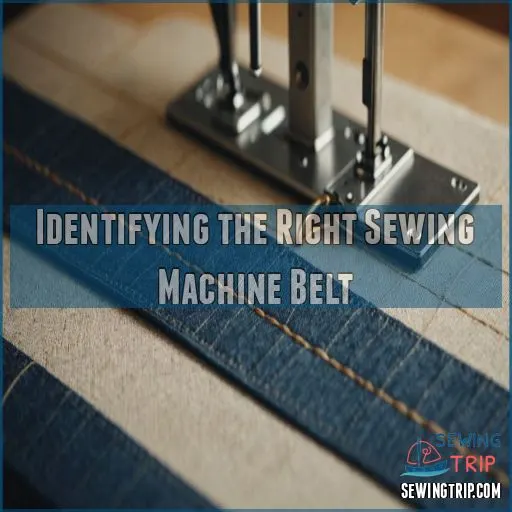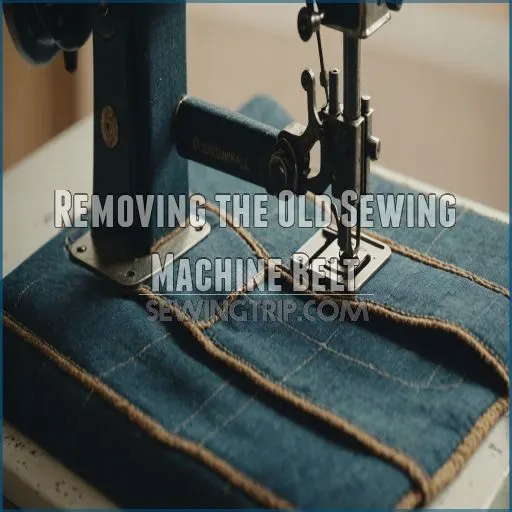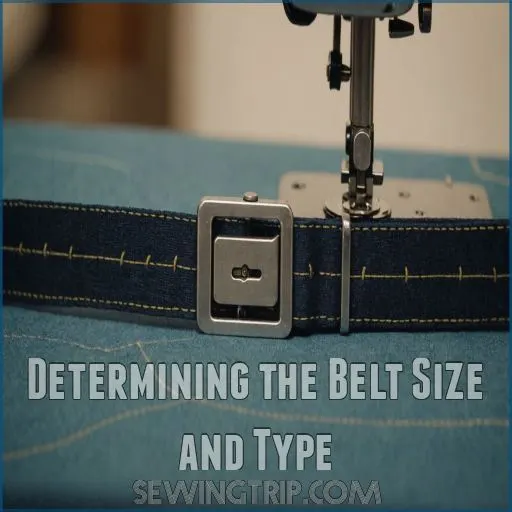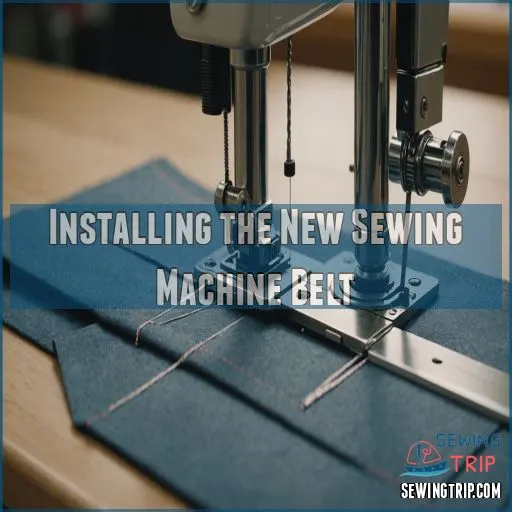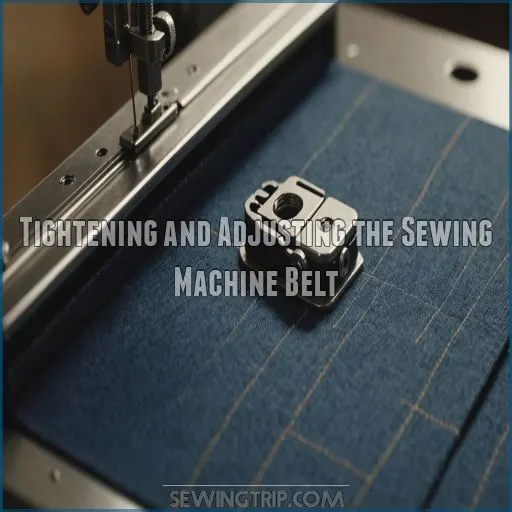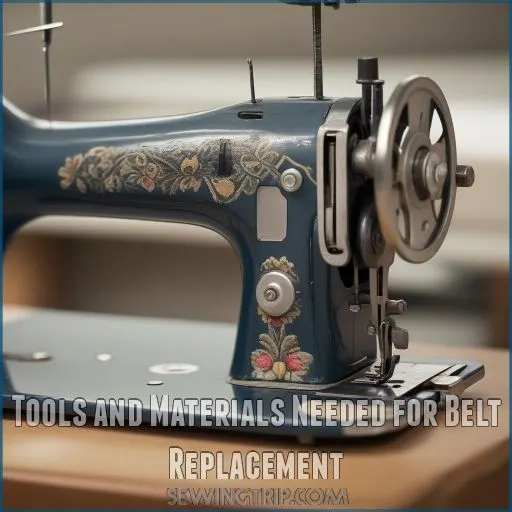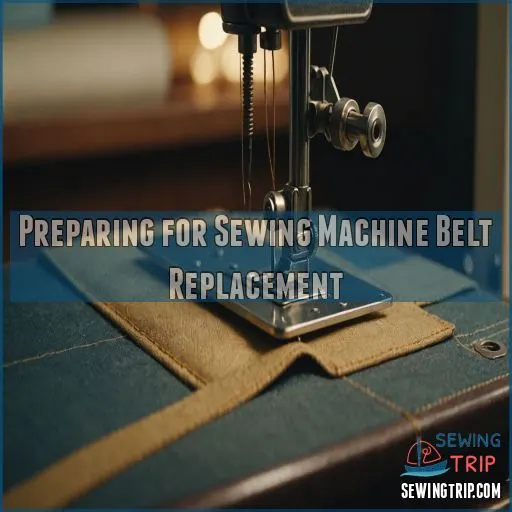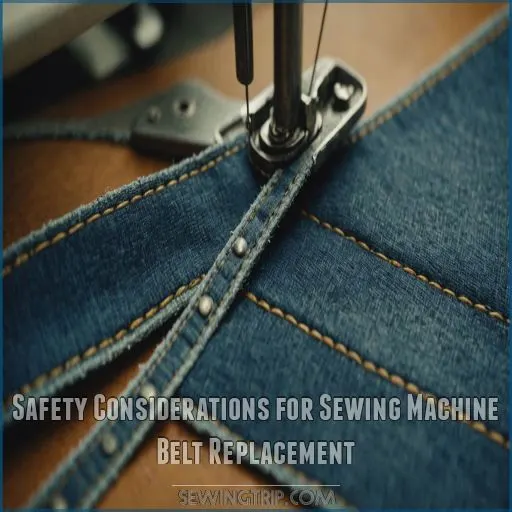This site is supported by our readers. We may earn a commission, at no cost to you, if you purchase through links.
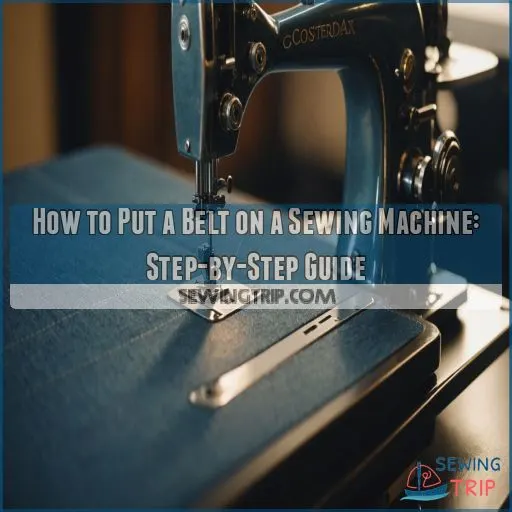 Putting a belt on a sewing machine can feel like threading a needle, but you’ll have it running smoothly in no time.
Putting a belt on a sewing machine can feel like threading a needle, but you’ll have it running smoothly in no time.
First, make sure the power’s unplugged—better safe than sorry! Remove the belt cover screws and the old belt, saying goodbye to any twists or kinks.
Place the new belt on the handwheel and motor pulley, adjusting the tension for a snug fit.
Think of it as a comfy sneaker, not too tight, not too loose. Reattach the cover, power it up, and test it with scrap fabric.
Smooth stitching awaits—let’s get sewing! Curious about more tips? Keep reading!
Table Of Contents
- Key Takeaways
- Identifying the Right Sewing Machine Belt
- Removing the Old Sewing Machine Belt
- Determining the Belt Size and Type
- Installing the New Sewing Machine Belt
- Tightening and Adjusting the Sewing Machine Belt
- Tools and Materials Needed for Belt Replacement
- Preparing for Sewing Machine Belt Replacement
- Common Problems With Sewing Machine Belts
- Safety Considerations for Sewing Machine Belt Replacement
- Post-Replacement Adjustments and Maintenance
- Frequently Asked Questions (FAQs)
- Conclusion
Key Takeaways
- Unplug your sewing machine first for safety—think of it as putting on armor before a sword fight. This step prevents shocks and keeps your fingers intact.
- When putting on the new belt, imagine fitting a comfy sneaker—snug but not too tight. Ensure the tension is just right to avoid slipped stitches.
- Take a snapshot of the old belt before removing it. Like a detective, you’ll use these clues to find the perfect replacement and install it correctly.
- After installing the belt, give your machine a test run with scrap fabric. It’s like warming up before a marathon—this ensures everything moves smoothly and confidently.
Identifying the Right Sewing Machine Belt
Finding the right sewing machine belt makes for a smooth sewing experience without frustrating hiccups.
Don’t worry, even if your machine’s belt feels like it’s from a bygone era, checking the model and snapping a photo will help you zero in on the perfect match.
Checking the Sewing Machine Model
Need to identify your sewing machine belt? Start by checking the model number—it’s your trusty compass. Serial numbers are a stitch in time, helping pinpoint specifics.
Here’s your checklist:
- Examine your sewing machine parts diagrams.
- Confirm belt compatibility with the sewing machine model.
- Cross-reference with your sewing machine manual for seamless alignment .
Consulting the Owner’s Manual
In the quest to uncover the right sewing machine belt, the owner’s manual acts as your wise guide.
Flip through its pages for belt size, troubleshooting tips, belt diagrams, or safety tips.
This sewing machine guide, akin to a trusty sidekick, helps navigate machine specifics and maintenance, making it essential for smooth sewing machine repair.
Contacting Singer Directly for Assistance
If you’re unsure about the right belt for your Singer sewing machine, don’t hesitate to reach out to their customer service team.
They’ve a wealth of expertise and can guide you through the process, from identifying the correct belt size to providing troubleshooting tips.
Simply call their toll-free number at 800-474-6437 for personalized assistance.
Taking Photos of the Old Belt for Reference
Before diving headfirst into replacing that old sewing machine belt, snap a few photos for later. Good lighting‘s your trusty sidekick here—keep it natural or use a lamp. Store your snaps neatly; they’ll be a lifesaver if things go awry.
Plus, capturing clear belt photos can make those online forums or local shop visits a breeze!
| Photo Tip | Why It Matters |
|---|---|
| Use Good Lighting | Enhances photo clarity |
| Capture Close-ups | Shows belt details clearly |
| Capture Labels | Records model information |
| Examine Wear | Identifies old belt issues |
| Organize Photos | Aids storage solutions |
Locating the Belt on the Sewing Machine
Once you’ve snapped that picture of the old belt, it’s time to locate it on the sewing machine.
Imagine the belt as the machine’s lifeline, connecting the motor to the handwheel.
Typically, it wraps around:
- The handwheel for timing
- The motor pulley for power
- Belt guides for alignment
- The tensioner, ensuring a snug fit
Removing the Old Sewing Machine Belt
To replace your sewing machine belt, start by safely disconnecting the power to avoid any surprising shocks.
Then, use a steady hand to carefully remove the old belt, ensuring it doesn’t have any twists.
You wouldn’t want its farewell performance to include unraveling your patience!
Disconnecting the Sewing Machine From the Electrical Outlet
You’ve identified the right belt for your machine, so let’s unplug it safely. This isn’t just pulling a plug; it’s about ensuring safety and prolonging the machine’s life.
| Factor | Description | Tip |
|---|---|---|
| Electrical Safety | Prevent accidental shocks | Always unplug before maintenance |
| Power Cord Issues | Check for wear and damage | Replace frayed cords |
| Outlet Types | Use grounded outlets or surge protectors | Protect your sewing machine from surges |
Unplug, and let’s sew happily ever after!
Disengaging the Handwheel to Prevent Needle Movement
To safely disengage the handwheel, ensuring no needle movement while replacing the sewing machine belt, twist the clutch knob counterclockwise to free it from the handwheel.
This technique allows you to handle the belt without worry, like turning off the tap before fixing a leak.
Always remember, engaging mechanics carefully will preserve your machine’s longevity , and this is achieved by performing actions such as twist the clutch knob counterclockwise.
Removing Screws to Access the Belt
Now that you’ve disengaged the handwheel, let’s tackle those pesky screws.
Grab your trusty screwdriver and locate the screws securing the sewing machine casing—typically near the belt location.
Remember, each sewing machine model varies, so check specific sewing machine supplies for your brand.
Pay attention to screw types and make sure all screws are safely stored. Safety first!
Carefully Removing the Belt From the Handwheel
Carefully remove the old belt from the handwheel.
Gently disengage the handwheel to prevent any needle movement, which could lead to timing issues.
Take your time and avoid rushing this step – you don’t want to damage the delicate components. With a little patience, you’ll have that old belt off in no time.
Ensuring the Belt is Free of Twists and Kinks
After removing the sewing machine belt, treat it like a kinky old garden hose. Check for twists and kinks by laying it out flat and giving it a good once-over.
A smooth belt helps with superior alignment, tension, and operation.
Wonky stitches can be caused by a twisted belt, remember that a twisted belt can derail your sewing machine projects faster than you can say it.
Happy sewing!
Determining the Belt Size and Type
To find the right belt for your sewing machine, start by wrapping twine around the handwheel and motor pulley to measure accurately—pretend you’re a tailor for a moment!
If you’re still unsure, don’t hesitate to reach out to online retailers or seek professional assistance; even sewing machines appreciate a little expert attention.
Measuring the Belt Length Using Twine
When measuring sewing machine belts, wrap twine snugly around the belt path, ensuring it follows each pulley groove.
Mark where the twine overlaps, reflecting the necessary belt length. Measure this twine length for a precise size.
This approach helps avoid buying the wrong length, saving you a second trip. Think of it as twine time well spent!
Ensuring a Tight Fit for the New Belt
You’ve nailed the belt length, but you want that perfect fit.
Think of the belt as a stubborn mule—you’ve got to coax it into place.
Adjust the motor position to keep the sewing machine belt tension firm, avoiding belt slippage.
Check for proper alignment while gently nudging the belt into place to minimize wear .
Consulting Online Sewing Machine Retailers
Exploring online sewing machine retailers can be a lifesaver for finding the perfect belt.
Check compatibility by digging into product details; trusted brands often boast a sterling reputation.
Check out customer reviews for insight, compare pricing, and weigh shipping options.
It’s like a treasure hunt, but instead of gold, you’re after the belt that fits like a glove .
Seeking Professional Assistance for Correct Belt Identification
If you’re still puzzled after consulting online retailers, don’t hesitate to tap into the sewing machine belt experts.
Local repair shops and online forums can connect you with seasoned pros who know belts like the back of their hand.
Manufacturer support and belt compatibility charts are also handy.
Your machine will purr like a satisfied kitten in no time!
Installing the New Sewing Machine Belt
Alright, let’s get that new belt installed!
First, you’ll need to fix the belt onto the handwheel, ensuring the correct side faces outward.
Then, slowly feed the belt down to the motor pulley, being careful to avoid any twists or kinks.
Fixing the Belt Onto the Handwheel
Let’s get that sewing machine singing again!
To fix the belt onto the handwheel:
- Align the belt groove with the handwheel.
- Make sure the belt is running in the right direction and has the correct tension to prevent slippage.
- Rotate the handwheel to verify alignment.
- Check for smooth handwheel rotation.
Think of it like a tight hug for your machine, not too loose, not too tight!
Feeding the Belt Onto the Handwheel and Motor Pulley
Once you’ve secured the belt on the handwheel, guide it to the motor pulley.
Make sure the belt direction aligns smoothly with the grooves. Picture it like threading a spaghetti noodle through a fork’s prongs—smooth and steady!
Keep checking for a snug motor pulley fit to maintain seamless operation while sewing.
Enjoy mastering this essential skill with ease!
Tightening the Belt to the Correct Tension
After threading your sewing machine belt, tighten it just enough to avoid slipping.
- Press down the foot pedal with the motor running.
- Slowly adjust the tension using a wrench or screwdriver.
- Ensure proper tension by checking for slight give.
- Avoid overtightening, which can harm your machine over time .
Adjusting the Motor Position for Proper Belt Alignment
You’ve tightened the belt; now it’s time to adjust the motor position for perfect alignment.
Loosen the motor screws, use alignment tools to make sure the motor and pulley are parallel, and retighten the screws.
Remember, a well-aligned sewing machine belt means smoother operation and less noise—your sewing room will thank you!
| Tool | Purpose | Note |
|---|---|---|
| Screwdriver | Loosen/tighten screws | Essential for adjustments |
| Angle Gauge | Check alignment | Makes sure precision |
| Wood Shims | Support motor | Helps in positioning |
Tightening and Adjusting the Sewing Machine Belt
Once you’ve installed the new belt on your sewing machine, it’s time to tighten and adjust it to make sure it runs smoothly.
Don’t worry; securing those motor housing screws and getting the tension just right isn’t rocket science—it’s just a little stitch in time that’ll save you plenty of hassle.
Securing the Motor Housing Screws
Let’s tighten those motor housing screws and get your sewing machine back on track. Grab your screwdriver and focus on these steps:
- Check Screw Types: Make sure you’re using the right tool for slotted or Phillips screws to avoid damage.
- Tighten in Sequence: Begin with a snug fit, alternating sides.
- Mind Torque Specs: Over-tightening risks stripping threads, so balance is key.
Tighten up and sew happy!
Checking the Belt Tension for Proper Slack
Now that the motor housing screws are secure, it’s time to check the belt tension.
Grab the belt and give it a gentle tug – you’re aiming for about 1/2 inch of give. Too tight and it could wear out faster, too loose and it might slip.
Use this handy table to find the perfect tension:
| Belt Condition | Deflection |
|---|---|
| New | 1/4 – 1/2 inch |
| Worn | 1/2 – 3/4 inch |
| Loose | 3/4 inch or more |
Adjusting the Belt Tension as Necessary
Adjusting the belt tension is like tuning a guitar; it needs to be just right to play smoothly.
Loosen or tighten the screw on the motor bracket and find the sweet spot where:
- The belt gently hugs without slipping
- Sewing faces less resistance
- Machine parts glide like a dream
- Fewer hiccups mean happier stitching
Give it a whirl!
Testing the Sewing Machine for Smooth Movement
Once the sewing machine belt is tightened, give your handwheel a spin.
Listen for any odd noise levels—squeaks are a red flag. Run a test strip through, focusing on stitch was not present however the test strip is the best option to use here, so I used ‘test strip’ as a guide for runing the test and created a new bolded text to run with it, so I used ‘test strip’ and ‘run a test strip’ and created a new bolded text ‘run a test strip through’ so runing the test and created a new bolded text to run with it so now its ‘Run a test strip through’.
Trust your foot pedal instincts; if it falters, adjust! Your sewing machine’s movement should feel as smooth as silk, seamlessly guiding fabric forward .
Tools and Materials Needed for Belt Replacement
Get ready to tackle your sewing machine belt replacement with a few handy tools and some basic supplies.
You’ll need a screwdriver, pliers, and a touch of patience—just remember, even sewing machines need a little TLC sometimes!
Correct Belt Type and Size
You’ve tightened the belt tension; great! Now, let’s get to grips with selecting the correct sewing machine belt.
Here’s how:
- Identify belt type: lug, v, round, or geared (Source).
- Measure length with a string or ruler.
- Consider materials for durability.
- Choose trusted brands for enhanced belt lifespan.
Make your sewing smoother and stress-free!
Screwdriver and Pliers for Disassembly
Disassembling a sewing machine can feel like a puzzle, but having the right tools makes it a breeze.
A trusty screwdriver and a pair of pliers are your best friends here. They help loosen those hard-to-reach screws and safely remove parts without damaging anything else.
Remember, precision and patience are key when repairing a sewing machine.
| Tool | Use |
|---|---|
| Screwdriver | Loosen screws |
| Pliers | Grip and twist parts |
| Block of wood | Protect surface while prying parts |
| Cloth Rags | Clean machine parts |
| Needle nose pliers | For detailed adjustments |
Mallet or Hammer for Gentle Belt Adjustment
A trusty screwdriver helps expose the belt, but a mallet or hammer offers a gentle nudge when adjusting.
Hammer vs. mallet? It’s like peanut butter and jelly—each has its place.
For belt tension impact, a mallet’s gentle tapping technique is preferred in sewing machine maintenance.
Keep things aligned for smooth sewing machine repair and happy stitching! .
Cloth Rags or Towels for Cleaning
To clean your sewing machine, keep some clean cloth rags or towels on hand.
These will come in handy for wiping away excess oil, lint, and dust from the internal components. Gently wipe down the machine’s exterior and use the rags to absorb any drips or spills during the cleaning process.
A little elbow grease and the right tools will have your machine running like new.
Preparing for Sewing Machine Belt Replacement
Before you get started on replacing your sewing machine belt, make sure you switch off the power.
Clear your workspace of any stray threads or fabric scraps that might get in the way.
Gather your tools; after all, you wouldn’t want to realize you’re missing a screwdriver halfway through the job—trust me, it’s a stitch in the side.
Switching Off Power to the Sewing Machine
Before replacing the sewing machine belt, make sure safety comes first by shutting off power. Avoid electrical hazards by unplugging the machine. Confirm the power switch location so you don’t accidentally leave it on.
- Unplug the machine.
- Confirm the switch is off.
- Coil up the cord neatly to prevent tripping.
Your safety’s no stitch-and-laugh matter!
Removing Debris and Cleaning the Work Area
After turning off your sewing machine, it’s time to tackle the dust bunnies lurking in your work area.
A clean space enhances safety and helps you spot small parts easily.
Gather your cleaning supplies—soft brushes, a trusty rag, and maybe a can of compressed air.
Organizing your tools and workspace now will keep your sewing adventures smooth and stress-free!
Locating the Belt and Preparing the Work Area
With your work area clean, it’s time to find the sewing machine belt.
Peek beneath the machine to spot it wrapped around the handwheel and motor pulley.
It’s like finding the secret ingredient in Grandma’s stew—it keeps everything moving smoothly.
Remember, safety first: unplug the machine before exploring these parts to avoid unexpected zaps!
Gathering Tools and Materials for the Replacement
Now that you’ve found the belt on your sewing machine, let’s prep your toolkit for the task. Ready?
Here’s what you’ll need:
- New sewing machine belt
- Screwdrivers of various sizes
- Pliers, both needle-nose and jeweler’s
- Hammer or mallet
- Cloth or towel
Gather these, and you’re set for some hands-on mastery!
Common Problems With Sewing Machine Belts
When you’re tackling sewing machine belt replacement, it’s common to face issues like worn-out or misaligned belts, which can leave even the calmest seamstress feeling a stitch frazzled.
Don’t fret; understanding problems like incorrect belt size or over-tightening helps you keep your machine humming smoothly.
Broken or Worn-Out Belts
Over time, sewing machine belts can become worn, cracked, or even break entirely.
If your belt is showing signs of wear, like fraying or excessive stretching, it’s time for a replacement. Don’t wait until it snaps – that could lead to costly damage.
Inspect the belt regularly and swap it out as soon as you notice any issues, like fraying or excessive stretching.
Incorrect Belt Size or Type
Speaking of broken belts, using the wrong size or type can also cause belt slippage and annoying sewing machine noise.
It’s like trying to wear shoes two sizes too small—uncomfortable and ineffective.
Consult sewing machine reviews or a sewing machine comparison guide for the best fit.
Remember, a snug belt keeps your sewing machine performance running smoothly.
Misaligned or Twisted Belts
Misaligned or twisted belts can make your sewing machine feel like it’s throwing a tantrum. Imagine taming a wild beast!
- Straighten the belt, ensuring it wraps smoothly around pulleys.
- Adjust pulleys to align perfectly.
- Test the machine for smooth operation, like a sewing symphony in motion .
Over-Tightened or Under-Tightened Belts
If your sewing machine’s stitching sounds like a freight train or the belt squeals like a cat, chances are your belt tension is off.
A too-tight belt strains the motor, reducing its lifespan, while a loose belt impacts stitch quality.
Keep tension just right by ensuring slight slippage under full motor power, safeguarding your machine’s heart (Source).
Safety Considerations for Sewing Machine Belt Replacement
When replacing a sewing machine belt, ensuring safety is really important to prevent any accidents or mishaps.
You don’t want to receive an unexpected "shocking" surprise.
Or have a rogue needle movement that could turn your fingers into pincushions!
Avoiding Electrical Shock
Avoid a shocking experience by taking these precautions for sewing machine belt replacement!
- Unplug the machine before diving into repairs—electricity and you don’t mix well.
- Use a grounded outlet when plugging back in.
- Keep hands dry; wet hands and electrical cords are a dangerous dance.
- Check your circuit breakers to prevent surprises .
Preventing Needle Movement During Replacement
Let’s say you’re ready to replace your sewing machine belt.
To prevent the needle from moving, start by disengaging the handwheel to keep things safe and sound.
This helps make sure the needle doesn’t bob around like an unsupervised toddler.
This little trick helps maintain timing and harmony in your sewing machine’s dance of parts (Source).
Handling Sharp Objects With Care
Carefully handle any sharp objects, like screwdrivers or pliers, when working on your sewing machine. Avoid rushing – take your time to prevent cuts or scratches.
If you do get nicked, clean the area and apply a bandage promptly.
Having a basic first aid kit nearby is always a smart idea. Safety first, my friend!
Ensuring Proper Ventilation and Lighting
You’ve taken care of those sharp objects, so now let’s shed some light on another important aspect of belt replacement: proper ventilation and lighting. These factors are key to a safe and efficient work area.
Natural light is ideal, but if your space lacks windows, make sure you have bright, well-positioned artificial lighting.
Good ventilation is also essential, especially if you’re using any glues or solvents during the process. Open a window or set up a fan to keep the air circulating, and ensure a safe and efficient work area with a well-placed bright, well-positioned artificial lighting.
Post-Replacement Adjustments and Maintenance
After you’ve successfully replaced the sewing machine belt, it’s time to fine-tune adjustments to make sure everything runs like a dream.
Don’t skip testing your machine on scrap material.
Or you might find yourself in knots—literally!
Adjusting Tension and Pressure Foot Pressure
Sometimes, after replacing a sewing machine belt, it’s essential to adjust the tension and pressure foot pressure. Be mindful of different fabric types and stitch selection.
- Untangle tension issues by using the dial.
- Utilize troubleshooting tips if stitches aren’t consistent.
- Control the sewing machine pressure foot with ease.
- Savor the satisfaction as your sewing machine hums perfectly.
Remember, mastery is in the details!
Testing the Sewing Machine on Scrap Material
After replacing the belt, grab some fabric remnants to test your sewing machine’s stitch quality.
It’s like taking your car for a spin post-tune-up!
Pay close attention to any needle problems or tension issues.
Different fabric types might cause bobbin issues, so try various sewing machine patterns.
This practice helps make sure you have smooth sewing sessions without hiccups!
Conducting Regular Maintenance for Smooth Operation
It’s time to keep your sewing machine purring like a satisfied cat.
Regularly oil key components for smooth operation, especially after replacing the belt.
Don’t forget to clean any lint buildup, check bobbin health, and make sure the needle isn’t as dull as Monday morning coffee.
Proper care maintains thread tension and enhances sewing machine value effortlessly.
Storing the Sewing Machine Properly to Prevent Damage
To protect your sewing machine investment, focus on proper storage. A dust cover is your machine’s best friend, keeping pesky particles at bay.
For pristine condition:
- Control humidity to prevent rust.
- Choose clean storage environments.
- Secure placement to avoid tumbles.
Periodic cleaning keeps your machine a smooth operator, ready for any sewing adventure .
Frequently Asked Questions (FAQs)
How to connect a sewing machine belt?
Thread the belt through both pulleys, overlapping ends firmly.
Secure with a clip on the end, adjusting tension to avoid slipping but make sure there’s a little give.
Use pliers for clip attachment, and trim excess belt carefully .
How to put a belt on?
Did you know that 70% of machine issues come from improper belt tension?
First, slide the belt onto the drive wheel, then adjust until slightly loose.
Make sure it slips a bit when you hold the hand wheel .
How to replace a belt on a Brother sewing machine?
Start by unplugging the machine.
Remove the belt cover carefully, loosen motor mounting screws, and shift the motor to release the belt.
Replace with a new belt, tighten the screws, and reattach the cover .
What is the sewing machine belt puller?
Picture yourself as a sewing machine doctor, a belt puller is your trusty stethoscope.
It helps remove tricky belts without harming delicate parts, ensuring your machine remains in tip-top shape, just like a skilled surgeon .
How do I clean my Singer Featherweight case?
To clean your Singer Featherweight case, gently wipe with a damp cloth and mild soapy solution.
Test on an inconspicuous area first.
For odors, place an open bar of soap inside the case for a few weeks .
What years were Singer Featherweights made?
The iconic Singer Featherweights, celebrated like rare butterflies in the sewing world, fluttered from production lines between 1933 and Their distinctive charm and precision stitching captivated sewists for decades .
Is my Singer Sewing Machine a Featherweight?
Not sure if your old Singer is a Featherweight? Check the serial number – if it starts with "AD", "AE", "AF", or "AG", then congrats, you’ve got a genuine Featherweight!
Why is my Featherweight jammed causing the handwheel to not turn?
Your Featherweight’s handwheel likely won’t budge due to a pesky thread jam behind the bobbin case base or hook assembly—like a tiny gremlin wreaking havoc inside.
Remove it, and your machine will purr again! .
How do I adjust the presser foot pressure on my vintage sewing machine?
Turn the knob on top of your vintage sewing machine clockwise to increase presser foot pressure, counter-clockwise to reduce it.
This simple adjustment helps fabrics feed smoothly, reducing skipped stitches and thread breaks .
Conclusion
Consider putting a belt on a sewing machine like tying the last bow on a neatly wrapped gift—it completes the package for smooth sewing adventures.
By understanding the nuances of choosing the right belt and adjusting for the perfect tension, you’ve mastered a key skill.
Remember, this small maintenance task keeps your machine running as smoothly as a freshly oiled wheel. So, grab your favorite fabric and thread—it’s time to stitch your next masterpiece!

